|
The Federal Reserve and Greece vied for investors' attention last week and it looks like the concerns about Greece trumped the news from the Fed. While attention slewed to the Fed, its monetary policy decision, forecasts and Chair Janet Yellen's quarterly press conference Wednesday, focus returned to Greece almost immediately. Equities were mixed on the week with the Shanghai Composite dropping into correction territory.
On Friday, the European Central Bank increased its emergency funding of Greece's financial system after efforts failed to broker a deal on the flailing bailout. It was the second time in the week that ECB officials had conferred over the troubled Greek financial system. The ECB has effectively kept Greek lenders on life support with billions of euros in emergency funding as anxious depositors accelerated their withdrawals from Greek banks. It was not immediately clear how much of an increase the ECB had provided.
A smaller group of finance ministers from the 19 countries that share the euro was unable Thursday evening in Luxembourg to negotiate a deal in the long-running crisis. The stalemate has heightened fears that Greece will default on a large loan repayment on June 30 and that it is on the brink of a possibly destabilizing exit from the currency bloc. Immediately after the talks ended Thursday evening without a breakthrough, an emergency summit meeting of 19 Eurozone leaders was scheduled for Monday. In part, the meeting was called to ease fears about the stability of the Greek banking system in the coming days. Analysts and bankers said they believed that about an additional €3 billion or about $3.4 billion was withdrawn from the Greek banks during the week.
Federal Reserve
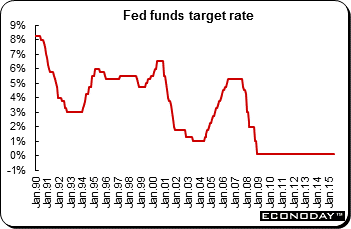 The Federal Reserve once again left its fed funds rate range at zero to 0.25 percent where it has been since December 2008. In the announcement, the FOMC appeared to be in no hurry to increase the fed funds rate. The FOMC's 2015 growth forecast was cut to 1.8 percent to 2.0 percent, but was virtually unchanged for 2016 and 2017 from its March estimates. The unemployment rate was moved up to 5.2 to 5.3 percent from 5.0 to 5.2 percent in March. The Federal Reserve once again left its fed funds rate range at zero to 0.25 percent where it has been since December 2008. In the announcement, the FOMC appeared to be in no hurry to increase the fed funds rate. The FOMC's 2015 growth forecast was cut to 1.8 percent to 2.0 percent, but was virtually unchanged for 2016 and 2017 from its March estimates. The unemployment rate was moved up to 5.2 to 5.3 percent from 5.0 to 5.2 percent in March.
Among the details, the statement said growth is expanding moderately after stalling in the first quarter and that the labor market is picking up. The consumer sector is described as moderate with housing improving. Business investment and exports continue to be soft. There is no change in the inflation assessment — it is still running below target and inflation expectations continue to be stable. The FOMC continues to see inflation rising gradually to its 2 percent target. It said risks to the economy and labor market remain balanced.
Bank of Japan
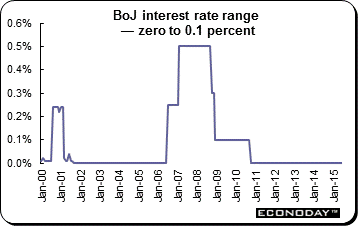 As expected, the Bank of Japan left its key interest rate range at zero to 0.1 percent. It said it would continue to buy JGBs at annual pace of ¥80 trillion. The vote to maintain its policy was 8 to 1. Takahide Kiuchi voted against the decision once again, arguing that a pace of purchases (¥45 trillion) was appropriate. As expected, the Bank of Japan left its key interest rate range at zero to 0.1 percent. It said it would continue to buy JGBs at annual pace of ¥80 trillion. The vote to maintain its policy was 8 to 1. Takahide Kiuchi voted against the decision once again, arguing that a pace of purchases (¥45 trillion) was appropriate.
The BoJ announced a new framework for its monetary policy meetings with the changes taking effect January 1, 2016. The changes include reducing the number of monetary policy board meetings from 14 to 8 and releasing an Outlook for Economic Activity and Prices on a quarterly basis. They will also release each policy board member's forecasts and risk assessments of the economy and prices. With the reduction, the BoJ joins the Federal Reserve, the ECB (which reduced its meeting frequency this year) and the Bank of England which intends to reduce its meeting schedule as well to hold eight meetings a year.
Swiss National Bank
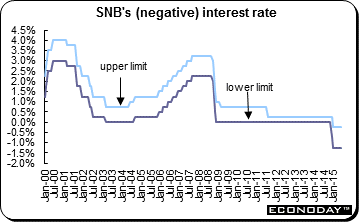 As expected, the Swiss National Bank announced no changes to key interest rates at its June Monetary Policy Assessment. The target range for 3-month CHF LIBOR was left at minus 1.25 to minus 0.25 percent with the deposit rate at minus 0.75 percent. Although it opted to abandon the EUR/CHF1.20 minimum exchange rate target in January, the SNB also indicated that would remain active in the foreign exchange market as needed to counter what it regards as the excessive overvaluation of the local currency. As expected, the Swiss National Bank announced no changes to key interest rates at its June Monetary Policy Assessment. The target range for 3-month CHF LIBOR was left at minus 1.25 to minus 0.25 percent with the deposit rate at minus 0.75 percent. Although it opted to abandon the EUR/CHF1.20 minimum exchange rate target in January, the SNB also indicated that would remain active in the foreign exchange market as needed to counter what it regards as the excessive overvaluation of the local currency.
The new inflation forecasts differed little from the last projections made in March. CPI inflation is seen holding at its current minus 1.2 percent annual rate through the third quarter of 2015 before rising slowly to end next year at minus 0.1 percent. Real GDP growth forecasts for this year and next were revised up marginally to minus 1.0 percent and minus 0.4 percent respectively. Even so, the economy is not seen expanding again until the second half of 2015.
There was little fresh information in the announcement which essentially just points to more of the same from the SNB over coming months. The Bank is clearly unhappy with the existing negative interest rate regime but with deflationary pressures still very marked and the Swiss franc uncomfortably firm, it has little choice.
|
|
2014 |
2015 |
% Change |
|
Index |
Dec 31 |
June 12 |
June 19 |
Week |
2015 |
| Asia/Pacific |
|
|
|
|
|
|
| Australia |
All Ordinaries |
5388.6 |
5552.1 |
5591.5 |
0.7% |
3.8% |
| Japan |
Nikkei 225 |
17450.8 |
20407.1 |
20174.2 |
-1.1% |
15.6% |
| Hong Kong |
Hang Seng |
23605.0 |
27280.5 |
26760.5 |
-1.9% |
13.4% |
| S. Korea |
Kospi |
1915.6 |
2052.2 |
2047.0 |
-0.3% |
6.9% |
| Singapore |
STI |
3365.2 |
3353.9 |
3301.0 |
-1.6% |
-1.9% |
| China |
Shanghai Composite |
3234.7 |
5166.4 |
4478.4 |
-13.3% |
38.4% |
|
|
|
|
|
|
|
| India |
Sensex 30 |
27499.4 |
26425.3 |
27316.2 |
3.4% |
-0.7% |
| Indonesia |
Jakarta Composite |
5227.0 |
4935.8 |
4985.0 |
1.0% |
-4.6% |
| Malaysia |
KLCI |
1761.3 |
1734.4 |
1721.8 |
-0.7% |
-2.2% |
| Philippines |
PSEi |
7230.6 |
7503.7 |
7601.17 |
1.3% |
5.1% |
| Taiwan |
Taiex |
9307.3 |
9301.9 |
9218.4 |
-0.9% |
-1.0% |
| Thailand |
SET |
1497.7 |
1508.2 |
1491.5 |
-1.1% |
-0.4% |
|
|
|
|
|
|
|
| Europe |
|
|
|
|
|
|
| UK |
FTSE 100 |
6566.1 |
6784.9 |
6710.5 |
-1.1% |
2.2% |
| France |
CAC |
4272.8 |
4901.2 |
4815.4 |
-1.8% |
12.7% |
| Germany |
XETRA DAX |
9805.6 |
11196.5 |
11040.1 |
-1.4% |
12.6% |
| Italy |
FTSE MIB |
19012.0 |
22877.8 |
22699.4 |
-0.8% |
19.4% |
| Spain |
IBEX 35 |
10279.5 |
11030.5 |
10944.3 |
-0.8% |
6.5% |
| Sweden |
OMX Stockholm 30 |
1464.6 |
1597.3 |
1562.4 |
-2.2% |
6.7% |
| Switzerland |
SMI |
8983.4 |
9026.4 |
8867.3 |
-1.8% |
-1.3% |
|
|
|
|
|
|
|
| North America |
|
|
|
|
|
|
| United States |
Dow |
17823.1 |
17898.8 |
18014.2 |
0.6% |
1.1% |
|
NASDAQ |
4736.1 |
5051.1 |
5117.0 |
1.3% |
8.0% |
|
S&P 500 |
2058.9 |
2094.1 |
2109.8 |
0.7% |
2.5% |
| Canada |
S&P/TSX Comp. |
14632.4 |
14741.2 |
14653.1 |
-0.6% |
0.1% |
| Mexico |
Bolsa |
43145.7 |
44692.5 |
44973.4 |
0.6% |
4.2% |
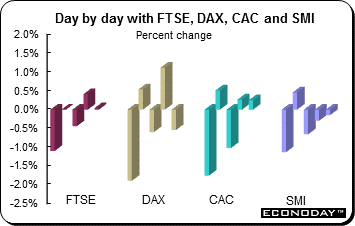 Equities retreated last week as the situation with Greece ground on. With investors paying very close attention to the ebb and flow of the dialogue between Greece and its creditors, securities fluctuated too. An example was Friday when the majority of the European markets ended in the green. The gains were fueled by investor optimism for a last minute deal on Greece. After Thursday's meeting of Eurozone finance ministers failed to yield an agreement, an emergency meeting is now scheduled for Monday prior to an emergency summit in Brussels. For the week, the FTSE lost 1.1 percent, the CAC and SMI both lost 1.8 percent and the DAX retreated 1.4 percent. Equities retreated last week as the situation with Greece ground on. With investors paying very close attention to the ebb and flow of the dialogue between Greece and its creditors, securities fluctuated too. An example was Friday when the majority of the European markets ended in the green. The gains were fueled by investor optimism for a last minute deal on Greece. After Thursday's meeting of Eurozone finance ministers failed to yield an agreement, an emergency meeting is now scheduled for Monday prior to an emergency summit in Brussels. For the week, the FTSE lost 1.1 percent, the CAC and SMI both lost 1.8 percent and the DAX retreated 1.4 percent.
Markets here were closed for the day prior to the Federal Reserve's policy announcement Wednesday. However, the meeting's outcome did help morale Thursday when equities advanced for the day. Many market watchers thought the Fed would lay further groundwork for a rate increase as soon as September, but policy makers remained reluctant to tip their hand even though economic activity seems to be picking up after a second consecutive rough winter.
In some relief for Greece, the European Central Bank Governing Council on Friday raised the emergency liquidity assistance, or ELA, for Greek banks by €3.3 billion, slightly less than what the Bank of Greece had reportedly sought. The ECB had held an emergency conference call to review the funding assistance to Greek banks which are facing accelerated withdrawals. The ECB also warned that Greek banks may not open on Monday, citing officials who took part in the Eurogroup meeting on Thursday. Deposit flight may force Greece to impose capital controls, becoming only the second country after the neighboring Cyprus to use the measure in the euro area.
Most economic data last week came from the UK — and just about all of it was good news. The sole disappointment was the continued decline of producer output or factory gate prices. However, the jobless picture continued to be good and earnings finally began to show some life. Retail sales advanced and consumer prices were once again in positive territory. A big disappointment was the decline in sentiment as measured by the German ZEW survey.
 Trading outside of mainland China for the most part of last week was dominated by both the expected reaction to the Federal Reserve and the actual reaction to it. Of course, investors also had their eyes on Greece. Undoubtedly, Greece will continue to be the focus of traders into the new week, with matters expected to reach a climax. There was little new economic data to influence trading. Trading outside of mainland China for the most part of last week was dominated by both the expected reaction to the Federal Reserve and the actual reaction to it. Of course, investors also had their eyes on Greece. Undoubtedly, Greece will continue to be the focus of traders into the new week, with matters expected to reach a climax. There was little new economic data to influence trading.
Only four of 12 indexes advanced last week as worries regarding Greece and the expected Federal Reserve policy announcement weighed on investor sentiment. The Sensex gained 3.4 percent thanks to the improving monsoon in an El Niño year. Tame inflation reports spurred hopes that the Reserve Bank of India will cut rates for a fourth time this year. Sentiment was also helped by the positive global reaction to the Fed's dovish policy statement on interest rate increases. These helped to push "Grexit" worries to the back burner. For the record, the All Ordinaries (0.7 percent), Jakarta Composite (1.0 percent) and the PSEi (1.3 percent) also were up for the week.
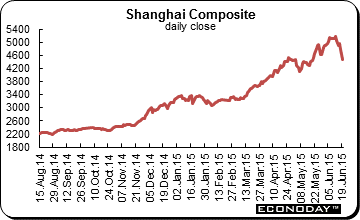 The Shanghai Composite tumbled 13.3 percent last week as a selloff picked up steam Friday. The weekly performance ranks as the worst weekly performance since a 13.8 percent drop for the week ended June 13, 2008 and also the second biggest weekly drop of the past decade. The index is now in correction territory. Increased regulatory scrutiny on margin lending in recent weeks as well as numerous initial public offerings that have drawn money from the secondary market have kept investors in a jittery mood amid what remains an otherwise strong rally. Despite this week's declines, the Shanghai Composite is up 38.4 percent to be the world's best-performing market so far in 2015. The Shanghai Composite tumbled 13.3 percent last week as a selloff picked up steam Friday. The weekly performance ranks as the worst weekly performance since a 13.8 percent drop for the week ended June 13, 2008 and also the second biggest weekly drop of the past decade. The index is now in correction territory. Increased regulatory scrutiny on margin lending in recent weeks as well as numerous initial public offerings that have drawn money from the secondary market have kept investors in a jittery mood amid what remains an otherwise strong rally. Despite this week's declines, the Shanghai Composite is up 38.4 percent to be the world's best-performing market so far in 2015.
Some analysts now think Beijing is more likely to step in with further stimulus, helping to prop up the markets. Since November, the People's Bank of China has cut interest rates three times and banks' reserve requirement ratios twice.
Despite the weekly loss, the Nikkei managed to regain the 20,000 level after sliding below it Thursday for the first time since May 18. The index lost 1.1 percent on the week. On Friday, the Nikkei rebounded from Thursday's one month low after the BoJ maintained its massive stimulus program as expected to spur inflation.
 The U.S. dollar retreated against all of its major counterparts including the euro, yen, pound sterling, Swiss franc and the Canadian and Australian dollars. The currency retreated after the Federal Reserve declined to indicate when the first fed funds rate increase will occur. The promise of only a 'gradual' pace of rate increases by the Fed sent the dollar lower as the foreign exchange market switched its focus from the Greece crisis. The U.S. dollar retreated against all of its major counterparts including the euro, yen, pound sterling, Swiss franc and the Canadian and Australian dollars. The currency retreated after the Federal Reserve declined to indicate when the first fed funds rate increase will occur. The promise of only a 'gradual' pace of rate increases by the Fed sent the dollar lower as the foreign exchange market switched its focus from the Greece crisis.
The euro has recovered after plunging to a 12-year intraday low under $1.05 in March from nearly $1.40 last August. Its decline was based on the view that the U.S. Federal Reserve was getting closer to raising interest rates, which strengthened the dollar. At the same time, the European Central Bank embarked on a €60 billion ($68 billion) stimulus program which is set to continue until late 2016 and that weakened the euro. But many felt the euro dropped too far too fast, especially given a pickup in growth in the Eurozone. At the same time, the broader dollar rally has stalled, with investors saying the much anticipated Fed rate increase was already reflected in the dollar's value.
While the Greek negotiations took a heavy toll on equities and bonds last week, the euro advanced. The euro jumped Thursday on hopes of a breakthrough in Greece's financial crisis, while the dollar weakened on U.S. inflation data that left traders even more uncertain about when the Federal Reserve will begin to increase interest rates. But the biggest euro gains quickly faded as officials denied a report that Greece would avoid a debt default.
Sterling added to recent gains against the dollar, rising to a seven month high Thursday, after climbing on Wednesday from better than expected British wage growth.
|
|
2014 |
2015 |
% Change |
|
|
Dec 31 |
June 12 |
June 19 |
Week |
2015 |
| U.S. $ per currency |
|
|
|
|
|
|
| Australia |
A$ |
0.817 |
0.773 |
0.777 |
0.5% |
-4.9% |
| New Zealand |
NZ$ |
0.780 |
0.698 |
0.690 |
-1.2% |
-11.5% |
| Canada |
C$ |
0.861 |
0.812 |
0.815 |
0.3% |
-5.4% |
| Eurozone |
euro (€) |
1.210 |
1.126 |
1.134 |
0.8% |
-6.2% |
| UK |
pound sterling (£) |
1.559 |
1.556 |
1.587 |
2.0% |
1.8% |
|
|
|
|
|
|
|
| Currency per U.S. $ |
|
|
|
|
|
|
| China |
yuan |
6.206 |
6.208 |
6.209 |
0.0% |
-0.1% |
| Hong Kong |
HK$* |
7.755 |
7.753 |
7.752 |
0.0% |
0.0% |
| India |
rupee |
63.044 |
64.060 |
63.563 |
0.8% |
-0.8% |
| Japan |
yen |
119.820 |
123.390 |
122.690 |
0.6% |
-2.3% |
| Malaysia |
ringgit |
3.497 |
3.761 |
3.744 |
0.5% |
-6.6% |
| Singapore |
Singapore $ |
1.325 |
1.343 |
1.335 |
0.7% |
-0.7% |
| South Korea |
won |
1090.980 |
1114.630 |
1107.050 |
0.7% |
-1.5% |
| Taiwan |
Taiwan $ |
31.656 |
31.076 |
30.784 |
0.9% |
2.8% |
| Thailand |
baht |
32.880 |
33.656 |
33.665 |
0.0% |
-2.3% |
| Switzerland |
Swiss franc |
0.9942 |
0.929 |
0.917 |
1.3% |
8.4% |
| *Pegged to U.S. dollar |
|
|
|
|
|
|
| Source: Bloomberg |
|
|
|
|
|
|
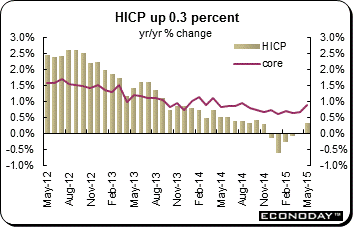 May harmonized index of consumer prices was up 0.2 percent on the month and 0.3 percent from a year ago. The increase was broad based. On the year, inflation picked up for non-energy industrial goods and services along with food, alcohol & tobacco. However, energy prices continued to drop. Core HICP which excludes food, alcohol, tobacco & energy was 0.9 percent, up 0.3 percentage points from April. Omitting only unprocessed food & energy, the HICP was also up 0.9 percent. May harmonized index of consumer prices was up 0.2 percent on the month and 0.3 percent from a year ago. The increase was broad based. On the year, inflation picked up for non-energy industrial goods and services along with food, alcohol & tobacco. However, energy prices continued to drop. Core HICP which excludes food, alcohol, tobacco & energy was 0.9 percent, up 0.3 percentage points from April. Omitting only unprocessed food & energy, the HICP was also up 0.9 percent.
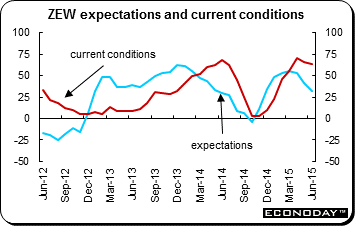 June ZEW survey shows analysts becoming rather more cautious about both the current state of the German economy as well as its medium-term outlook. At 62.9 the current conditions gauge was 2.8 points short of its May reading and at a 3-month low. Expectations remained on the downtrend that started in April. A 10.4 point drop lifted the cumulative decline since the end of last quarter to 23.3 points to leave the index at 31.5, its weakest level since last November. Recent and disappointingly sluggish economic news at home together with a Greek financial crisis that finally seems to be reaching a climax seem to have weighed on sentiment this month. That said, both measures remain at historically high levels so there is nothing here to suggest that German growth is about to dry up. June ZEW survey shows analysts becoming rather more cautious about both the current state of the German economy as well as its medium-term outlook. At 62.9 the current conditions gauge was 2.8 points short of its May reading and at a 3-month low. Expectations remained on the downtrend that started in April. A 10.4 point drop lifted the cumulative decline since the end of last quarter to 23.3 points to leave the index at 31.5, its weakest level since last November. Recent and disappointingly sluggish economic news at home together with a Greek financial crisis that finally seems to be reaching a climax seem to have weighed on sentiment this month. That said, both measures remain at historically high levels so there is nothing here to suggest that German growth is about to dry up.
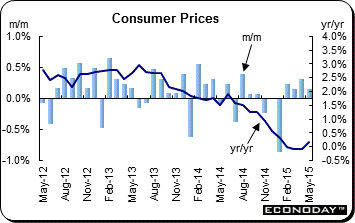 May consumer prices were up 0.2 percent on the month and 0.1 percent from a year ago. The annual headline rate was boosted by a 0.6 percent monthly jump in transport costs which compared with a 0.7 percent fall over the same period in 2014. Air transport fares were notably firm but this may be a function of the timing of Easter. Higher petrol charges also had a positive impact. The other main lift came from food & non-alcoholic drinks where a 0.1 percent monthly dip was much smaller than the 1.1 drop posted a year ago. On the downside the principal effect was from recreation & culture where prices fell 0.1 percent versus April after a 0.4 percent rise in the same period in 2014. Core CPI was up 0.1 percent and 0.9 percent on the year. May consumer prices were up 0.2 percent on the month and 0.1 percent from a year ago. The annual headline rate was boosted by a 0.6 percent monthly jump in transport costs which compared with a 0.7 percent fall over the same period in 2014. Air transport fares were notably firm but this may be a function of the timing of Easter. Higher petrol charges also had a positive impact. The other main lift came from food & non-alcoholic drinks where a 0.1 percent monthly dip was much smaller than the 1.1 drop posted a year ago. On the downside the principal effect was from recreation & culture where prices fell 0.1 percent versus April after a 0.4 percent rise in the same period in 2014. Core CPI was up 0.1 percent and 0.9 percent on the year.
 May producer input prices were down 0.9 percent on the month and dropped 12.0 percent on the year. Factory gate (output) prices were just 0.1 percent firmer than in April and stood 1.6 percent lower on the year. Within the monthly gain in overall output prices the only increase of note was in petroleum products where charges jumped 2.0 percent. Most other subsectors were relatively subdued and the core index was only flat at April's level and 0.1 percent higher on the year, also matching its previous reading. The slide in monthly input costs was dominated by a 6.9 percent slump in home food materials and a 2.0 percent decline in imported food materials. Imported metals and other imported materials were down. Partial offsets were provided by gains in crude oil and other home produced materials. May producer input prices were down 0.9 percent on the month and dropped 12.0 percent on the year. Factory gate (output) prices were just 0.1 percent firmer than in April and stood 1.6 percent lower on the year. Within the monthly gain in overall output prices the only increase of note was in petroleum products where charges jumped 2.0 percent. Most other subsectors were relatively subdued and the core index was only flat at April's level and 0.1 percent higher on the year, also matching its previous reading. The slide in monthly input costs was dominated by a 6.9 percent slump in home food materials and a 2.0 percent decline in imported food materials. Imported metals and other imported materials were down. Partial offsets were provided by gains in crude oil and other home produced materials.
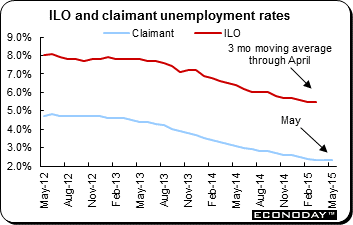 May claimant count unemployment was down 6.500 — its weakest decline in more than 2 years and not enough to reduce the jobless rate which weighed in at 2.3 percent for a third consecutive month. The ILO statistics painted a similar picture of moderating economic growth as unemployment over the latest three months declined a relatively mild 43,000, well short of its 102,000 decrease in November to January. The jobless rate on this measure was also unchanged at 5.5 percent. However, average earnings were surprisingly robust. At an annual rate of 2.7 percent, growth in the three months to April was well above expectations, up from a stronger revised 2.3 percent in the first quarter and the fastest since July 2011. May claimant count unemployment was down 6.500 — its weakest decline in more than 2 years and not enough to reduce the jobless rate which weighed in at 2.3 percent for a third consecutive month. The ILO statistics painted a similar picture of moderating economic growth as unemployment over the latest three months declined a relatively mild 43,000, well short of its 102,000 decrease in November to January. The jobless rate on this measure was also unchanged at 5.5 percent. However, average earnings were surprisingly robust. At an annual rate of 2.7 percent, growth in the three months to April was well above expectations, up from a stronger revised 2.3 percent in the first quarter and the fastest since July 2011.
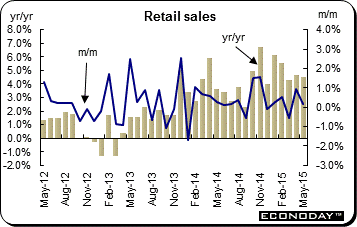 May retail sales edged up 0.2 percent on the month after gaining a downwardly revised 0.9 percent April. Annual growth was 4.6 percent. Excluding auto fuel, purchases were also up 0.2 percent from the start of the quarter and 4.4 percent higher on the year, a couple of ticks short of the April pace. May's monthly rise was dominated by the food sector where sales were up a solid 0.6 percent. By contrast, excluding auto fuel, non-food demand dipped 0.1 percent. Prices were up from April with the overall deflator advancing 0.4 percent on the month and the ex-auto fuel gauge 0.3 percent higher. Even so, annual inflation rates remained solidly in negative territory at minus 2.7 percent and minus 1.8 percent respectively. May retail sales edged up 0.2 percent on the month after gaining a downwardly revised 0.9 percent April. Annual growth was 4.6 percent. Excluding auto fuel, purchases were also up 0.2 percent from the start of the quarter and 4.4 percent higher on the year, a couple of ticks short of the April pace. May's monthly rise was dominated by the food sector where sales were up a solid 0.6 percent. By contrast, excluding auto fuel, non-food demand dipped 0.1 percent. Prices were up from April with the overall deflator advancing 0.4 percent on the month and the ex-auto fuel gauge 0.3 percent higher. Even so, annual inflation rates remained solidly in negative territory at minus 2.7 percent and minus 1.8 percent respectively.
 Japanese merchandise trade figures for May disappointed, as weakness in the yen did little to boost exports. Japan's merchandise trade deficit expanded to Y216.0 billion from Y55.8 in April. Exports were up a weak 2.4 percent from the same month a year ago while imports dropped 8.7 percent or more than double the 4.2 percent pace in April. The decline of the yen makes imports more expensive. However, the drop in imports also reflected weaker consumption. The decline in petroleum prices also dented imports. Exports to the U.S. were up 7.4 percent on the year for the seventh consecutive rise. However, this followed a jump of 21.3 percent in April. Exports to China were up 1.1 percent for the third consecutive increase but down from 2.4 percent the month before. Exports to the EU were up 0.4 percent for the sixth increase after 0.8 percent. On a seasonally adjusted basis, the trade deficit was Y182.5 billion after a deficit of Y240 billion in April. On the month, exports were down 2.7 percent and imports lost 3.5 percent. In April, when the exchange rate averaged Y119.6 per dollar, exports increased 8 percent. Although the exchange rate fell to Y124 per dollar by late May, the deterioration didn't seem to have helped much. Japanese merchandise trade figures for May disappointed, as weakness in the yen did little to boost exports. Japan's merchandise trade deficit expanded to Y216.0 billion from Y55.8 in April. Exports were up a weak 2.4 percent from the same month a year ago while imports dropped 8.7 percent or more than double the 4.2 percent pace in April. The decline of the yen makes imports more expensive. However, the drop in imports also reflected weaker consumption. The decline in petroleum prices also dented imports. Exports to the U.S. were up 7.4 percent on the year for the seventh consecutive rise. However, this followed a jump of 21.3 percent in April. Exports to China were up 1.1 percent for the third consecutive increase but down from 2.4 percent the month before. Exports to the EU were up 0.4 percent for the sixth increase after 0.8 percent. On a seasonally adjusted basis, the trade deficit was Y182.5 billion after a deficit of Y240 billion in April. On the month, exports were down 2.7 percent and imports lost 3.5 percent. In April, when the exchange rate averaged Y119.6 per dollar, exports increased 8 percent. Although the exchange rate fell to Y124 per dollar by late May, the deterioration didn't seem to have helped much.
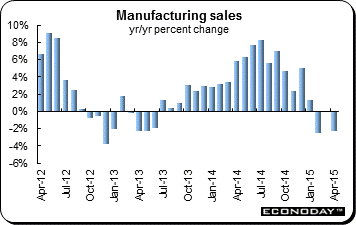 April manufacturing sales dropped 2.1 percent on the month and were down 2.3 percent from a year ago. Volumes, which were exceptionally robust in March, fell a smaller 1.0 percent from March and were flat on the year. Within the monthly drop in total nominal sales, food and petroleum & coal products retreated. Primary metals were lower and transport equipment plunged on the back of a near-18 percent slide in aerospace products and parts. On the positive side, chemicals and plastics & rubber advanced as did electrical equipment, appliances & components. April manufacturing sales dropped 2.1 percent on the month and were down 2.3 percent from a year ago. Volumes, which were exceptionally robust in March, fell a smaller 1.0 percent from March and were flat on the year. Within the monthly drop in total nominal sales, food and petroleum & coal products retreated. Primary metals were lower and transport equipment plunged on the back of a near-18 percent slide in aerospace products and parts. On the positive side, chemicals and plastics & rubber advanced as did electrical equipment, appliances & components.
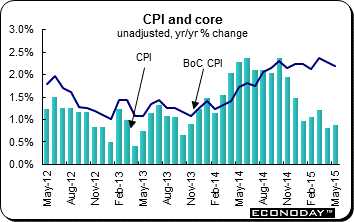 May consumer price index was up 0.6 percent on the month and 0.9 percent from a year ago. Core CPI excluding food and energy was up 0.2 percent from the start of the quarter to yield an annual rate of 1.8 percent. At the same time, the BoC's preferred measure which excludes eight volatile items increased a monthly 0.4 percent, reducing its yearly rate from 2.3 percent to 2.2 percent. Seasonal factors are quite positive in May and after adjusting for these the overall CPI rose 0.4 from April when it dipped 0.1 percent. Similarly adjusted, the ex-food and energy index was 0.1 higher and the BoC's measure 0.2 percent stronger. Within the adjusted basket the main upward pressure came from recreation, education & reading. Elsewhere, transportation also saw an above average gain while clothing and footwear was the only area of obvious weakness. May consumer price index was up 0.6 percent on the month and 0.9 percent from a year ago. Core CPI excluding food and energy was up 0.2 percent from the start of the quarter to yield an annual rate of 1.8 percent. At the same time, the BoC's preferred measure which excludes eight volatile items increased a monthly 0.4 percent, reducing its yearly rate from 2.3 percent to 2.2 percent. Seasonal factors are quite positive in May and after adjusting for these the overall CPI rose 0.4 from April when it dipped 0.1 percent. Similarly adjusted, the ex-food and energy index was 0.1 higher and the BoC's measure 0.2 percent stronger. Within the adjusted basket the main upward pressure came from recreation, education & reading. Elsewhere, transportation also saw an above average gain while clothing and footwear was the only area of obvious weakness.
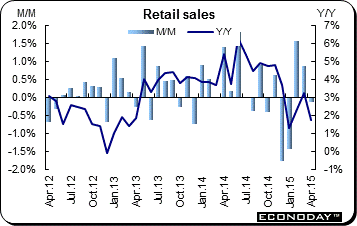 April retail sales slipped 0.1 percent following successive increases in February and March. Purchases were up only 1.7 percent from a year ago, well short of the upwardly revised 3.2 percent annual rate posted last time. Within the monthly decline in total nominal sales there were declines in four of the eleven subsectors. The main areas of weakness were electronic & appliances and food & beverages. Gasoline was also off. But for strength in motor vehicles & parts sales would have decreased 0.6 percent. Other sizeable increases were recorded in building material & garden equipment and supplies, clothing & accessories and sporting goods & hobbies. April retail sales slipped 0.1 percent following successive increases in February and March. Purchases were up only 1.7 percent from a year ago, well short of the upwardly revised 3.2 percent annual rate posted last time. Within the monthly decline in total nominal sales there were declines in four of the eleven subsectors. The main areas of weakness were electronic & appliances and food & beverages. Gasoline was also off. But for strength in motor vehicles & parts sales would have decreased 0.6 percent. Other sizeable increases were recorded in building material & garden equipment and supplies, clothing & accessories and sporting goods & hobbies.
The Greek crisis continued unabated last week. Although the crisis has been going on for some time, investors continue to follow the details closely. The Federal Reserve maintained the status quo at their FOMC meeting with little suggestion of when the Bank will increase interest rates. The Swiss National Bank also maintained the status quo at their quarterly assessment. The Bank of Japan, while not changing its current monetary policy, is changing the way it conducts and informs its decisions.
Greece will be in the spotlight in the coming week. A hastily announced summit will be held on Monday of all Eurozone presidents and prime ministers to Brussels. The goal is to find a solution to Greece's bailout standoff. Elsewhere, flash June PMIs will be reported for the Eurozone, Germany, France, Japan, China and the United States. Japan will post consumer prices, unemployment and household spending for May. But all will be closely monitoring the situation with Greece as the June 30 deadline for repayment to the IMF nears.
| The following indicators will be released this week... |
| Europe |
|
|
| June 23 |
Eurozone |
Manufacturing, Services & Composite PMI (June flash) |
|
Germany |
Manufacturing, Services & Composite PMI (June flash) |
|
France |
Manufacturing, Services & Composite PMI (June flash) |
| June 24 |
Germany |
Ifo Business Survey (June) |
|
France |
Gross Domestic Product (Q1.2015 final) |
| June 26 |
Eurozone |
M3 Money Supply (May) |
| |
|
|
| Asia/Pacific |
|
|
| June 23 |
China |
PMI Manufacturing (June flash) |
|
Japan |
PMI Manufacturing (June flash) |
| June 26 |
Japan |
Consumer Price Index (May) |
|
|
Unemployment (May) |
|
|
Household Spending (May) |
Anne D Picker is the author of International Economic Indicators and Central Banks.
|

